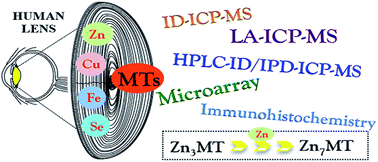当前位置:
X-MOL 学术
›
J. Anal. At. Spectrom.
›
论文详情
Our official English website, www.x-mol.net, welcomes your feedback! (Note: you will need to create a separate account there.)
Quantitative distribution of Zn, Fe and Cu in the human lens and study of the Zn–metallothionein redox system in cultured lens epithelial cells by elemental MS†‡
Journal of Analytical Atomic Spectrometry ( IF 3.4 ) Pub Date : 2017-06-07 00:00:00 , DOI: 10.1039/c6ja00431h Héctor González-Iglesias 1, 2, 3, 4, 5 , Carson Petrash 1, 2, 3, 4, 5 , Sara Rodríguez-Menéndez 1, 2, 3, 4, 5 , Montserrat García 1, 2, 3, 4, 5 , Lydia Álvarez 1, 2, 3, 4, 5 , Luis Fernández-Vega Cueto 1, 2, 3, 4, 5 , Beatriz Fernández 1, 2, 3, 4, 5 , Rosario Pereiro 1, 2, 3, 4, 5 , Alfredo Sanz-Medel 6, 7, 8 , Miguel Coca-Prados 1, 2, 3, 4, 5
Journal of Analytical Atomic Spectrometry ( IF 3.4 ) Pub Date : 2017-06-07 00:00:00 , DOI: 10.1039/c6ja00431h Héctor González-Iglesias 1, 2, 3, 4, 5 , Carson Petrash 1, 2, 3, 4, 5 , Sara Rodríguez-Menéndez 1, 2, 3, 4, 5 , Montserrat García 1, 2, 3, 4, 5 , Lydia Álvarez 1, 2, 3, 4, 5 , Luis Fernández-Vega Cueto 1, 2, 3, 4, 5 , Beatriz Fernández 1, 2, 3, 4, 5 , Rosario Pereiro 1, 2, 3, 4, 5 , Alfredo Sanz-Medel 6, 7, 8 , Miguel Coca-Prados 1, 2, 3, 4, 5
Affiliation

|
The human lens is constantly subjected to exogenous and endogenous stressors, leading to oxidative cellular damage and, with time, to cataract formation. Metallothioneins (MTs) are a group of important enzymes that use metals (i.e., Zn and Cu) to protect tissues from the deleterious effects of free radicals associated with oxidative stress. This work combines elemental mass spectrometry with bio-analytical methodologies to determine (i) the total amount, the quantitative speciation and the cellular distribution of trace elements (i.e., Zn, Fe, and Cu) in human lenses and their corresponding capsules; and (ii) the effects of “exogenous” metal (i.e., 68ZnSO4, isotopically enriched in 68Zn) and stressor (i.e., IL-1α) on the zinc–MT redox system in cultured human lens epithelial cells (HLEsv) in vitro. Of all the elements analyzed, Zn was the most abundant, and it was equally present in both the capsule (9.7 ± 2.5 μg g−1 tissue) and the lens (9.5 ± 1.2 μg g−1 tissue). In contrast, Fe was found to be more than 6-fold more abundant in the capsule (1.6 ± 0.4 μg g−1) than in the lens (0.2 ± 0.1 μg g−1). Zinc in the lens is mainly associated with high molecular mass proteins, whereas in the capsule it is mostly bound to low and medium molecular mass proteins. The localization of Zn, Cu and MTs in the lens showed their preferential co-distribution in the lens epithelial cell layer, underneath the anterior capsule. Exogenous Zn is capable of inducing a stoichiometric change in MT proteins from Zn3–MT to Zn7–MT within lens epithelial cells in vitro, which may be related to their antioxidant capacity.
中文翻译:

元素MS对Zn,Fe和Cu在人晶状体中的定量分布以及培养的晶状体上皮细胞中Zn-金属硫蛋白氧化还原系统的研究† ‡
人晶状体不断受到外源性和内源性压力的作用,导致氧化性细胞损伤,并随着时间的流逝而导致白内障的形成。金属硫蛋白(MTs)是一组重要的酶,它们使用金属(即Zn和Cu)来保护组织免受与氧化应激相关的自由基的有害影响。这项工作将元素质谱与生物分析方法相结合,以确定(i)人晶状体及其相应胶囊中微量元素(即Zn,Fe和Cu)的总量,定量形态和细胞分布;和(ii)“外源的”金属的影响(即,68的ZnSO 4,同位素富集68锌)和应力源(即,IL-1α在培养的人晶状体上皮细胞(锌- MT的氧化还原体系HLEsv)上)在体外。在所有分析的元素中,Zn含量最高,并且在胶囊(9.7±2.5μgg -1组织)和晶状体(9.5±1.2μgg -1组织)中均存在。与此相反,铁被认为是超过6倍在胶囊(1.6±0.4微克克更丰富-1比在所述透镜(0.2±0.1微克克)-1)。晶状体中的锌主要与高分子量蛋白质有关,而在胶囊中,锌主要与中低分子量蛋白质结合。Zn,Cu和MTs在晶状体中的定位显示它们在前囊下方的晶状体上皮细胞层中的优先共分布。外源性锌能够在体外诱导晶状体上皮细胞中MT蛋白从Zn 3 -MT到Zn 7 -MT的化学计量变化,这可能与其抗氧化能力有关。
更新日期:2017-06-07
中文翻译:

元素MS对Zn,Fe和Cu在人晶状体中的定量分布以及培养的晶状体上皮细胞中Zn-金属硫蛋白氧化还原系统的研究† ‡
人晶状体不断受到外源性和内源性压力的作用,导致氧化性细胞损伤,并随着时间的流逝而导致白内障的形成。金属硫蛋白(MTs)是一组重要的酶,它们使用金属(即Zn和Cu)来保护组织免受与氧化应激相关的自由基的有害影响。这项工作将元素质谱与生物分析方法相结合,以确定(i)人晶状体及其相应胶囊中微量元素(即Zn,Fe和Cu)的总量,定量形态和细胞分布;和(ii)“外源的”金属的影响(即,68的ZnSO 4,同位素富集68锌)和应力源(即,IL-1α在培养的人晶状体上皮细胞(锌- MT的氧化还原体系HLEsv)上)在体外。在所有分析的元素中,Zn含量最高,并且在胶囊(9.7±2.5μgg -1组织)和晶状体(9.5±1.2μgg -1组织)中均存在。与此相反,铁被认为是超过6倍在胶囊(1.6±0.4微克克更丰富-1比在所述透镜(0.2±0.1微克克)-1)。晶状体中的锌主要与高分子量蛋白质有关,而在胶囊中,锌主要与中低分子量蛋白质结合。Zn,Cu和MTs在晶状体中的定位显示它们在前囊下方的晶状体上皮细胞层中的优先共分布。外源性锌能够在体外诱导晶状体上皮细胞中MT蛋白从Zn 3 -MT到Zn 7 -MT的化学计量变化,这可能与其抗氧化能力有关。


























 京公网安备 11010802027423号
京公网安备 11010802027423号